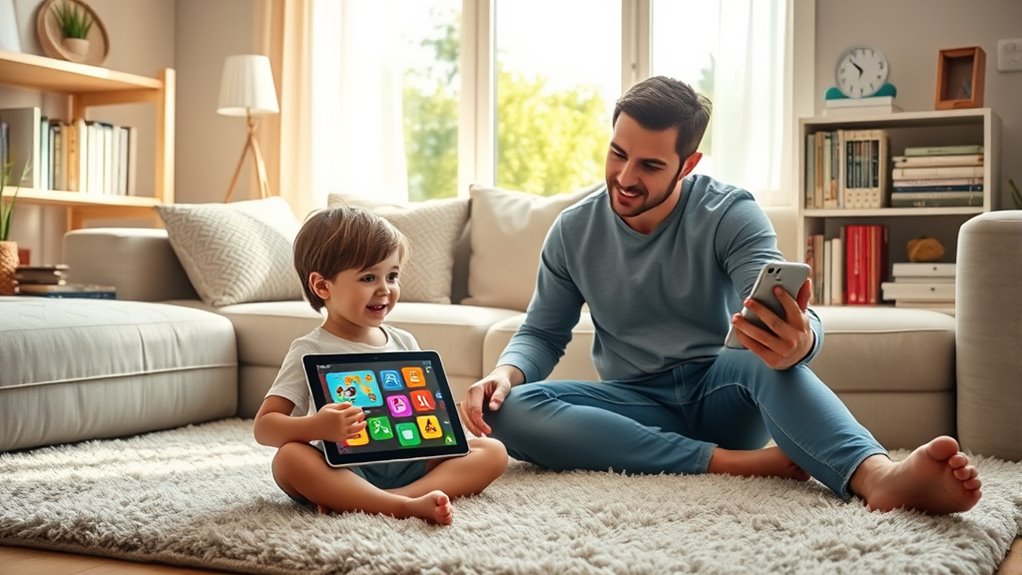To safely manage your children’s screen time with apps, set clear boundaries and use parental controls to monitor and restrict access. You can limit daily usage, block certain websites or apps, and even pause screens remotely. Explain the reasons behind these limits to help your child understand and develop healthy habits. Combining these tools with open discussions encourages responsible tech use. Keep exploring for more tips on creating a balanced digital routine.
Key Takeaways
- Use parental control apps to set daily screen time limits and restrict access to inappropriate content.
- Choose age-appropriate apps and customize restrictions based on your child’s maturity level.
- Enable remote management features to monitor and adjust controls remotely as needed.
- Clearly communicate the purpose of controls to teach responsible app usage and reinforce boundaries.
- Combine app controls with open discussions to promote healthy habits and understanding of technology use.

With screens becoming an integral part of daily life, managing children’s screen time is more important than ever. As a parent, you want to ensure that your child benefits from technology without falling into its potential pitfalls. One effective way to do this is by leveraging parental controls. These tools allow you to monitor and regulate what your child can access, helping you set limits on screen usage and prevent exposure to inappropriate content. By activating parental controls on devices, apps, and platforms, you gain peace of mind knowing that your child is engaging with screens safely. But simply installing controls isn’t enough. It’s equally important to actively participate in setting boundaries around screen time.
Setting boundaries is not about banning screens completely; rather, it’s about creating a healthy balance. You want your child to enjoy their devices without letting screens take over their daily routine. Start by establishing clear rules about when and where screens can be used. For example, you might designate specific times for screen use, such as after homework and chores are completed, and avoid screens during family meals or right before bedtime. Communicate these boundaries clearly and consistently, so your child understands why these rules are in place. Explaining that limits help them stay focused, sleep better, and spend quality time with family makes boundaries more meaningful rather than feeling like restrictions.
Using parental controls can support these boundaries effectively. Many apps and devices let you set daily time limits, restrict access to certain websites or apps, and even pause screens remotely. This prevents your child from exceeding the allotted time or wandering into inappropriate content without your knowledge. You can also customize controls based on age, ensuring that your child’s screen experience remains appropriate and safe. When combined with open conversations about why limits matter, parental controls help reinforce the boundaries you’ve set. It’s not just about controlling screens but teaching your child healthy habits around technology use.
Frequently Asked Questions
How Can I Personalize App Restrictions for Different Age Groups?
You can personalize app restrictions for different age groups by using age-specific controls available in most parental control apps. Set up parental customization by selecting appropriate age ranges for each child, ensuring restrictions match their maturity levels. Adjust settings to limit access to certain apps and content, and regularly review these controls to adapt as your kids grow. This tailored approach helps keep screen time safe and suitable for each child’s needs.
Are There Any Apps That Track and Limit Screen Time Automatically?
Yes, there are restriction apps that offer automatic tracking and limit screen time for your kids. These apps monitor usage patterns, set daily limits, and automatically restrict access once the time is up. You can customize settings for different age groups, ensuring your children don’t spend too much time on screens. Using these apps helps you manage their screen time effortlessly while promoting healthier device habits.
How Do I Handle Resistance From Children When Limiting Screen Time?
Handling resistance from children is like sailing a stormy sea, but you can steer smoothly with patience. Use parental negotiation to listen to their concerns and explain why setting boundaries is important. Involve them in creating rules, making them feel empowered rather than restricted. Consistency and positive reinforcement help children accept limits, turning resistance into cooperation. Remember, your calm approach encourages understanding and respect for the boundaries you set.
What Are the Best Strategies for Encouraging Offline Activities?
You can encourage offline activities by setting a routine that includes outdoor play and creative crafts. Offer enticing options like nature walks, bike rides, or building projects to make offline activities appealing. Get involved by joining in or providing new supplies for crafts, making it fun and engaging. Reward their efforts with praise or small incentives to build excitement around unplugged play, helping them develop healthy habits naturally.
How Can I Monitor My Child’s Online Interactions Safely?
Imagine your child’s online world as a vast, uncharted ocean. You can navigate it safely with parental controls, acting as your lighthouse, illuminating potential dangers. Regularly check their interactions, talk openly about online safety, and set boundaries. Use monitoring tools to stay informed without invading privacy. This way, you guide them through digital waters confidently, ensuring they explore safely and grow into responsible internet users.
Conclusion
So, you’ve set strict limits and chosen the right apps—only to realize that your child’s greatest challenge might be resisting the lure of their device. Ironically, in trying to protect them from screens, you’ve created a digital world where restraint is the real struggle. But remember, with patience and consistency, you’ll help your child develop healthy habits—because sometimes, the best way to manage screens is to teach them that moderation is the real magic trick.









